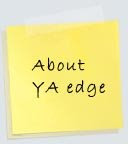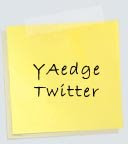Like the magnet on the YAedge mirror says “I chose the road less traveled. Now, where the hell am I?” There’s a reason we have that phrase featured front and center on our blog graphic.
I’m not the best plotter. I admit it. I usually wing my first draft and end up tossing half of the book because it wasn’t focused, or buried the real story under fun-to-write, but ultimately useless tangents. Kinda like that sentence…lol…
Keeping this in mind, imagine how I mentally cringed when my writer bud, Kitty Keswick and I decided to write a YA paranormal series together. That’s right, an entire series! The premise and characters ROCK, however, so there was no way I was bailing on the project. But the reality of choreographing the major/minor plotlines, developing characters over multiple books, creating backstory and then planning to leak that information in controlled bits throughout the series – holy, good God! And what’s more, we’re writing separate books, in sequence according to a strict timeline, with some unique characters, but a lot of them appear in all the books.
We had to create character cards for each major and minor character – physical descriptions, likes, dislikes, friends, enemies and throughlines/motives. We HAVE to know each other’s plots/characters as well as if we were watching Buffy season 6, for the millionth time. (Love the Buffy/Spike sex, seriously.)
But wow. Talk about a plotting nightmare.
Then I had a major brainwave. If we have to know our stories like our favourite TV shows, then damn it - we’d plot our series like a TV show. Each book would be an episode, each episode would build to its own resolution, yet still contribute to the overall story arc – leading to el grand finale in the final book.
Okay – that’s awesome. But how do you plot a TV series? I don’t really know how the studio guys do it, but after reading up on screenwriting, storyboards, index cards, beat sheets, etc. I’ve been able to wrap my noggin around the basics – enough at least to figure out a formula for our series.
It goes like this. Establish the different plots, separate them between overall story arc scenes and individual episode scenes – then mesh them together using the Three Act system (Act I – setup, Act II – conflict, Act III – climax).
So each episode, or book, comes down to a formula something like this:
- Plot A: major plot points that have to happen for the overall story arc of the series (30% of book)
- Plot B: major plot points for each episode and its own main characters (70% of book).
- Add a beat sheet of key interactions between characters that cross over from different episodes and key resolutions that must occur to keep the reader satisfied.
NOTE: as we get closer to the end of the series, the percentage of Plot A increases substantially. This keeps the momentum going, driving the story ever onward.
We now have a six book series, in sequence, with a record of how much of the overall story arc to focus on in each book - building the series to its dramatic end. (2 books for Acts I, II and III)
Cool, eh? And I never would have thought of it if it weren’t for the boob tube. ;) Is this close to how studio writers approach plotting out a series? Who knows, but it’s working for us. Now for the fun part – finishing the first drafts for this monster.
Want more information on writing scripts? Check out Script Frenzy (a writing competition, but the site has great tips)
Questions for Aprilynne Pike!
16 years ago










3 comments:
I'm also working on a series and have been struggling with this also. It's great that I'm not the only one who thinks comparing books to television totally makes sense! ;)
Whoot! WindyA - and I'm glad to know there are others experimenting with this method as well.....cool! Did you go so far as to use a script writing software? I tried Celtx - it's free and if you're writing with others, you can create a "studio" online and everyone can access the info. It's cool.
Awesome post, Tracy. Though I don't watch a ton of TV, I think writers can learn a lot. Each episode of a show has to keep the readers attention for 22 min or more, but also fit within the characters and the overall plot of the series.
There are several awesome storyboard books out there (some for animation, but still pretty much the same idea).
Post a Comment